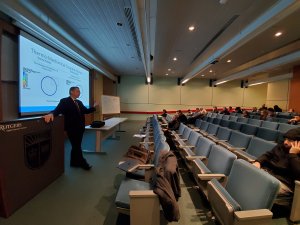
Mr. Joseph Englot, National Director of Infrastructure Security at HNTB, discussed alternative fuel vehicles, their behavior in fire events, and more at the seminar. Photo ©Dr. Roger Wang.
The presentation was related to a current collaborative CAIT UTC project studying tunnel fires that aims to increase safety and minimize economic losses in the transportation network by enhancing the resilience of existing and new tunnels.
Major tunnel fires can lead to catastrophic events potentially resulting in the loss of lives, property damage, long service disruptions, and major socioeconomic impacts. However, currently only limited guidelines and code provisions on the structural safety of tunnels under fire exist.
A collaborative University Transportation Center (UTC) project between Region 2 Consortium partners The University at Buffalo, New Jersey Institute of Technology (NJIT), Princeton University, and the Rutgers Center for Advanced Infrastructure and Transportation (CAIT) aims to change that.
The goal of the Fire in Tunnel Collaborative Project is to establish a framework to quantify fire damage to tunnel concrete lining considering soil-liner interaction. The outcome of this research can be used to design and assess new and existing tunnels for fire, and identify proper mitigation actions to minimize economic losses and meet the target performance level.
Led by Dr. Negar Elhami Khorasani, an assistant professor at The University at Buffalo’s Department of Civil, Structural and Environmental Engineering, working closely with Dr. Anthony Tessari also from The University at Buffalo; Dr. Maria Garlock, a professor in Princeton University’s Department of Civil & Environmental Engineering; and Dr. Bruno Gonçalves da Silva, an assistant professor at NJIT’s Department of Civil & Environmental Engineering; the team has been able to develop a traveling fire model and engage key stakeholders.
The research results were communicated and shared with these stakeholders every 6 months. Mr. Gary English, the retired Deputy Fire Chief of the Seattle Fire Department’s Underground Command and Safety, agreed to provide feedback on the project for example. Deputy Chief English has more than 30 years of experience in fire service and has been actively involved in several fire and tunnel related technical groups and panels including the National Fire Protection Association and the Transportation Research Board.
In late November, the Rutgers School of Engineering’s (SoE) Department of Civil and Environmental Engineering hosted Mr. Joseph Englot, National Director of Infrastructure Security at HNTB, to discuss a similar topic: alternative fuel vehicles and their behavior in fire events.
His presentation, “What Engineers Should Know About Alternative Fuel Vehicles,” discussed alternative fuel vehicles, their needs, benefits, risks, and more with the Rutgers community as part of the Department’s Fall 2019 Graduate Seminar Series.
The presentation reviewed the basic components and safety features of alternative fuel vehicles that have been manufactured to date and discussed some of the lessons learned from recent research and operations.
Mr. Englot identified some needs of alternative fuel vehicles too, such as establishing routine maintenance procedures, emergency response procedures and training for first responders, and risk analysis of vehicle behavior in fire events. Specifically, one major focus when it comes to fire events is the potential hazards posed by CNG and hydrogen-powered vehicles in vintage underwater-vehicular tunnels designed for gas-powered vehicles.
The Fire in Tunnel Collaborative Project at CAIT is also studying the effects of tunnel fires, from the perspective of its effects on tunnel-structure integrity. The majority of existing work in this area focuses on passenger safety, smoke control, and evacuation paths.
Dr. Khorasani recently presented some of her findings on this project at the IABSE Congress in New York City this September. Her paper, “Design fire scenarios for railway tunnel fires,” was published in the conference proceedings.
This January, Mr. Englot will return to Rutgers for a two-day training course on the community approach to resiliency planning at CAIT. The class will define what planning for resiliency means to a community’s ability to survive disaster, recover, and thrive in the future.
The training will start with a basic understanding of each communities’ hazards and threats as defined by state and local emergency preparedness plans, and progress with identifying vulnerabilities and best practice mitigations. The training also incorporates hands-on exercises, interactive discussions and real-life examples, that are targeted at enhancing the ability of engineers, planners, and government officials to understand the subject and make informed design decisions and assessments.

